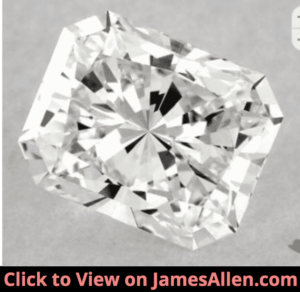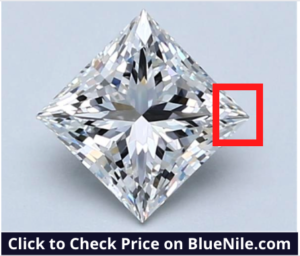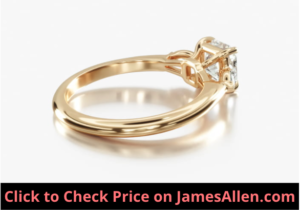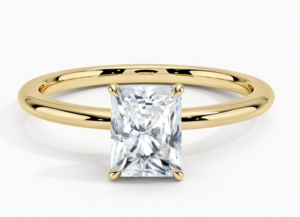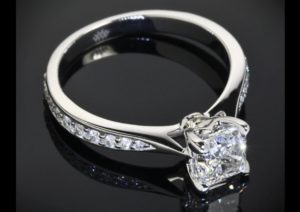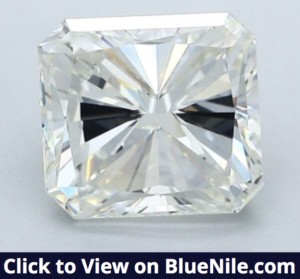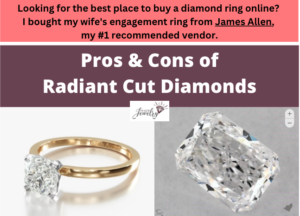
If you’re exploring fancy shape diamonds, you’ve likely considered radiant cuts.
These square or rectangular diamonds are fit as the center stone on an engagement ring or as an accent on another piece of jewelry.
It’s important you know what to expect from radiant cuts in terms of its appearance and performance.
Let’s explore 10 pros and cons of radiant cut diamonds so you’ll know if it’s right for you.
What is a Radiant Cut Diamond?
Radiant cut diamonds are known for their rectangular or square shape and cropped corners. It’s a brilliant cut with straight edges and 70 facets.
Check out this stunning radiant cut diamond ring, which is placed in a three-stone setting.
It’s from where I bought my wife’s engagement ring.
Its squarish shape is distinguishable from the trilliant cuts on either side.
Radiant cuts were the first square-shaped diamond with a brilliant facet pattern on its pavilion and crown.
It was invented by Henry Grossbard in the 1970s. He combined the techniques used to cut emerald and brilliant cuts.
That’s why radiant and emerald cuts have a similar outline, but radiant cuts have the facet pattern of round cuts.
Pros of Radiant Cuts
Strong Brilliance
Brilliance refers to the light performance of a diamond and how well it reflects white light back to the viewer.
It’s one of the most important aspects of a diamond, especially when it’s a center stone. If the diamond has a poor cut, light will leak through the pavilion and never return to the viewer.
Radiant cuts have strong brilliance because of the high number of facets and the quality of its cut.
In the high-resolution image below, you can identify its small, triangle-shaped facets.
They’re cut and polished in a way that allows light to collect inside the diamond and redirect back to your eyes.
In fact, its brilliance is balanced by scintillation. Some of the facets look dark while others flash. That quality is noticeable even in the photo above.
If you’re looking for an alternative to a round cut diamond that still sparkles when you twirl your ring, a radiant cut meets that criteria.
Available in Multiple Shapes
Most diamond cuts come in one shape. A round cut is always round, and a pear cut always has a rounded end that comes to a point on the other side.
Radiant cuts are available in both squares and rectangles. It’s not a particular length or width that distinguishes this cut.
Instead, it’s the straight edges, cropped corners, and brilliant cut facets.
Radiant cuts with a square shape have an optimal length-to-width ratio of 1.00-1.03. Even though a ratio of 1.03 isn’t a perfect square, it will resemble one to the naked eye.
Additionally, it will mimic a princess cut unless viewed up close. The only difference is its diagonal corners compared to the right angles on each side of a princess cut.

For rectangular radiant cuts, the ideal width is 1.20-1.30. It won’t stretch the diamond too thin, and you’ll notice the difference in its length and width without magnification.
Durability
The durability of a diamond refers to how likely it is to withstand the drops and impacts from everyday activities.
There are certain parts of a diamond more susceptible to chipping than others. One of these areas is sharp corners, like on baguette, trilliant, and princess cuts.
I’ve highlighted this type of corner on the diamond below.
Radiant diamonds are cut in a way that minimizes its vulnerability to chips. The beveled corners are less likely to break if struck against a hard surface.
You can add a layer of protection for radiant cuts with a strong setting.
Bezel settings protect the diamond with a ring of metal around its edge, but it reduces how much light the diamond can capture.
Instead, you can protect the corners with V-prongs or its sides with a basket setting.
The above radiant cut sits in a basket setting, where an additional ring of metal connects the prongs and surrounds the gem.
Lower Price Per Carat
Radiant diamonds have a lower price per carat compared to other cuts.
When manufacturers are cutting radiant diamonds, they use most of the original rough diamond.
To create other cuts such as round brilliant cuts, much of the rough diamond is thrown away. They have to charge more for those cuts to compensate.
There’s also lower demand for radiant cuts, which reduces the cost.
For a one-carat radiant cut with a G color grade and VS2 clarity, you can expect to pay between $3,500-$5,000.
As an example, James Allen, an online jewelry retailer, lists diamonds of this quality for an average of $4,056, with a range of $3,610-$4,910.
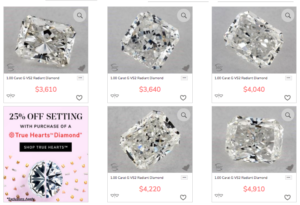
For a round cut diamond with those same qualities, the prices are between $5,410-$7,220. That’s close to a 50 percent increase for a round cut compared to a radiant cut.
As the quality of the radiant cut increases, so does the price.
For example, this one-carat radiant diamond with an F color grade and VVS2 clarity costs $8,030.
Because they have a lower cost per carat, you can put that savings toward qualities that are more important to you than its shape, such as carat, clarity, or a setting.
Fits a Variety of Settings
There are a variety of settings that complement a radiant cut. The most popular is a four-prong setting where one prong latches onto each corner.
Within this category, there are multiple types of prongs to choose. Rounded prongs are the traditional type.
Double claw prongs provide a slim look and added protection.
You can also add a prong on two sides for a six-prong setting, like this one.
Accents are a common way to add more glimmer and a higher total carat weight to a ring without a significant increase in price. These tiny diamonds can be placed around the radiant cut to form a halo or in u-shaped prongs that line the shank.
A channel setting, like this one from Whiteflash, adds elegance and sparkle to the piece.
Either in-store or through an online retailer, view how radiant cuts look in a number of settings. Don’t overlook the importance of a setting in creating an engagement ring.
By pairing diamonds with multiple shanks and styles of accents, you can find the best setting for your radiant cut.
Cons of Radiant Cuts
GIA Doesn’t Include Cut Grade
The Gemological Institute of America (GIA) is considered the most reputable organization providing diamond grading reports.
The GIA doesn’t provide cut grades for radiant cuts or other fancy shapes. A diamond’s cut is determined by how well its facets are aligned, its polish, symmetry, and proportions.
The GIA hasn’t developed guidelines for grading the cut quality for radiant diamonds, so you won’t see an objective grade listed.
That doesn’t mean all radiant cuts are created equal. You should still view the GIA’s grading information for all the traits listed above.
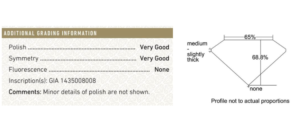
These are indicators of how well it’ll reflect light.
Additionally, view the diamond through a high-quality photo online or in-person. If it appears dull, that likely means it has a poor cut.
Bow-Tie Effect
The bow-tie effect in a radiant cut refers to black triangles that span across its center.
It’s an imperfection that forms when a diamond is cut and its facets don’t reflect light properly. No matter which direction you turn it, the bow-tie shape doesn’t go away.
This flaw is most often present in radiant and oval cuts.
In some cases, the bow-tie is barely visible, but in other instances, it’s more severe. There’s also nothing you can do to remove the bow-tie once it appears.
Here’s an example of the effect in an actual diamond.
Bow-ties aren’t listed on diamond grading reports, so it’s important you view the diamond before purchasing.
You can have two diamonds with identical reports, but one could have a bow-tie and the other could look flawless.
It doesn’t affect the durability of the stone, but you’ll have to decide if it’s worth a lower price for it to have that visible defect.
Appears Smaller Than Other Cuts
Buyers are often concerned with how large a diamond appears to the naked eye.
Diamonds aren’t traditionally measured by size. Instead, they’re measured in carats.
One carat equals 200 milligram.
Two diamonds that are both one carat are the same size, even if one appears larger.
Radiant cuts often look smaller than other cuts of the same carat weight. When viewed from the top, its surface area will appear smaller compared to round, oval, or marquise cuts.
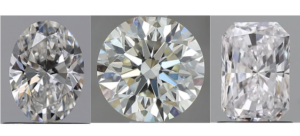
This is because much of its weight is hidden in the pavilion.
It improves the diamond’s brilliance but sacrifices surface area.
Doesn’t Disguise Color
A diamond’s color grade refers to the extent of yellow or brown tints.
Diamonds that are colorless receive the highest grades (D-F), and dark brown ones are on the other end of the spectrum (S-Z). Certain diamond cuts hide color better than others.
If you were to compare a round brilliant cut with an I color grade with a radiant cut of the same grade, the radiant cut would show more yellow.
It’s a result of it holding much of its weight in the pavilion, and it has shallow corners.
It’s also less brilliant, so there’s not as much white light to hide the yellow.
Most buyers want a diamond that appears colorless to the naked eye.
To achieve this effect, we recommend radiant cuts that earn at least an H color grade. Its yellow tints would not be visible in most cases, and you’d avoid the premiums charged for diamonds earning the colorless distinction.
Less Availability
If you’re looking for the cut with the most options available on the market, you should choose one more popular than radiant cuts.
They account for two to three percent of diamonds sold. Some industry estimates put radiant cuts as the eighth most common, below pear and oval.
If you’re searching for a radiant cut at any online or in-person retailer, you’ll have a wider range of options for round, cushion, princess, and marquise cuts.
For example, James Allen has about 4,000 radiant cuts in stock. For round diamonds, there are close to 200,000 in their inventory.
At Blue Nile, you can choose from 10,000 radiant cuts and 224,000 round cuts.
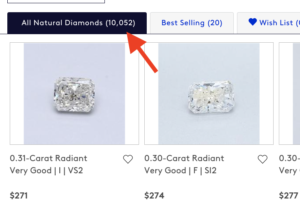
Even among fancy shapes, there are far fewer radiant cuts available. With cushion cuts, there are 9,400 to choose from, and for oval cuts, that number is 16,800.
That doesn’t mean radiant cut diamonds don’t come in a variety of colors and clarity.
At any of the major retailers, there are options for nearly every price range, where you can prioritize which characteristics are important to you.
Should You Choose a Radiant Cut Diamond?
Radiant cuts can serve as the center diamond in an engagement ring or as accents surrounding the stone or shank. A radiant cut may be right for you if:
- You want a brilliant cut diamond that’s an alternative to the popular round and princess cuts
- The square or rectangular shape with cropped corners is appealing to you
- You want to pay a lower price per carat to save money or put that savings toward other parts of the ring
- You’re concerned about the diamond chipping and want a durable cut
Explore a variety of radiant cuts, and pair them with multiple types of settings.
This allows you to view how the diamond appears in a solitaire setting, surrounded by a halo of diamonds, or on top of a shank lined with pavé.
Radiant cuts have many pros and cons, so it’s about understanding which traits are essential to your perfect ring and deciding if radiant cuts meet that criteria.

Jacob Clarke
Jacob Clarke is the founder of TeachJewelry.com.
He earned an Applied Jewelry Professional Diploma from the Gemological Institute of America (GIA) and now brings you essential information about diamonds, settings, and more.
Jacob has consulted with leading jewelry brands, and his work has been cited in Clean Origin, Diamond Nexus and industry publications.
He's also a member of the International Gem Society.
He enjoys discussing jewelry with readers, so contact him with any questions at jacob.clarke@teachjewelry.com.

